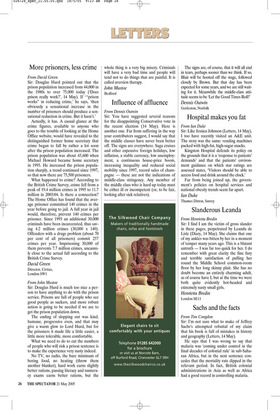More prisoners, less crime
From David Green
Sir: Douglas Hurd pointed out that the prison population increased from 44,000 in the 1980s to over 75,000 today (‘Does prison really work?’, 14 May). If ‘“prison works” in reducing crime,’ he says, ‘then obviously a sensational increase in the number of prisoners should produce a sensational reduction in crime. But it hasn’t.’ Actually, it has. A casual glance at the crime figures, available to anyone who goes to the trouble of looking at the Home Office website, would have revealed to the distinguished former home secretary that crime began to fall by rather a lot soon after the prison population increased. The prison population was about 45,600 when Michael Howard became home secretary in 1993. He increased the prison population sharply, a trend continued since 1997, so that now there are 75,500 prisoners.
What happened to crime? According to the British Crime Survey, crime fell from a peak of 19.4 million crimes in 1995 to 11.7 million in 2003/04. Is there a connection? The Home Office has found that the average prisoner committed 140 crimes in the year before going to jail. A full year in jail would, therefore, prevent 140 crimes per prisoner. Since 1993 an additional 30,000 criminals have been incarcerated, thus saving 4.2 million crimes (30,000 x 140). Offenders with a drugs problem (about 70 per cent of all prisoners) commit 257 crimes per year. Imprisoning 30,000 of them prevents 7.7 million crimes, uncannily close to the actual fall according to the British Crime Survey.
David Green Director, Civitas, London SW1

























































 Previous page
Previous page